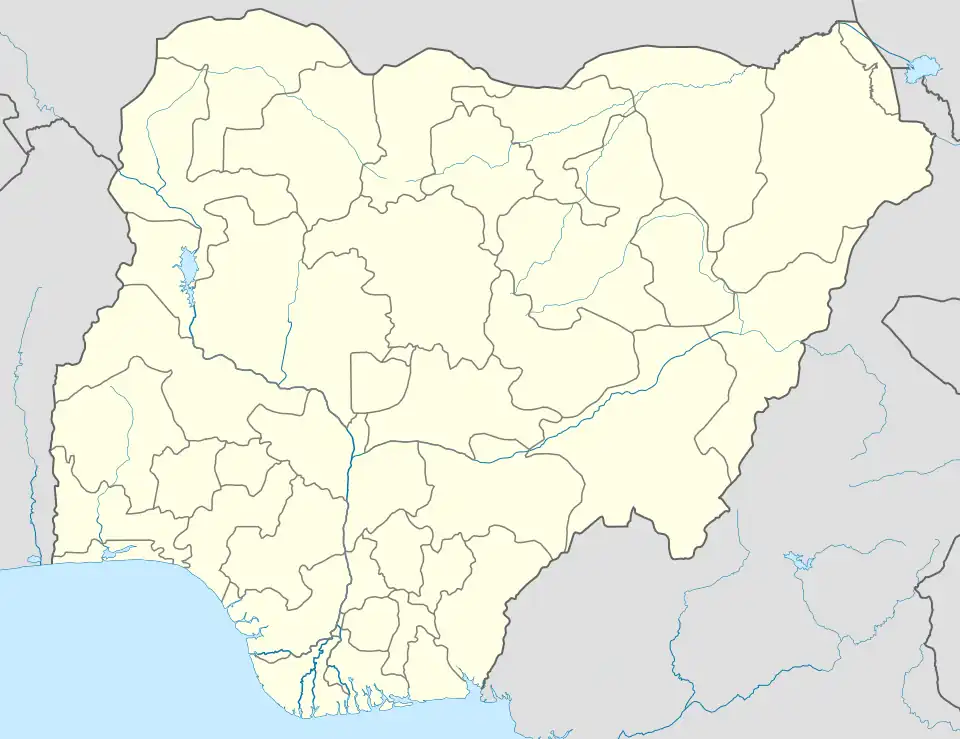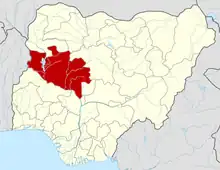Suleja | |
|---|---|
LGA and city | |
 Suleja | |
| Coordinates: 9°10′33″N 7°10′49″E / 9.17583°N 7.18028°E | |
| Country | |
| State | Niger State |
| Government | |
| • Local Government Chairman and the Head of the Local Government Council | Isyaku Bawa Na’ibi[1] |
| • Emir | Awwal Ibrahim |
| Population (2016) | |
| • Total | 260,240 |
| Time zone | UTC+1 (WAT) |
| Climate | Aw |
Suleja is a city in Niger State, Nigeria, pop. (2016) local government area, 260,240, just north of Abuja, capital of the Suleja Emirate. It is sometimes confused with the nearby city of Abuja, due to its proximity, and the fact that it was originally called Abuja before the Nigerian government adopted the name from the then Emir Sulayman Bal for its new federal capital in 1976.[2]
It was established in the early 19th century by Mohammed Makau, the last Hausa emir of Zaria and his followers who were fleeing the Fulani jihadists engaged in the conquest of northern Nigeria.[3] Zaria, or Zazzau, was one of the Hausa city/states of Northern Nigeria which were being conquered by the Fulani jihadists under their charismatic Sheik, Usman bin Fodio.
It is the location of the Ladi Kwali Pottery Centre, established by Michael Cardew in 1950.[4] The leading exponent of this school of pottery was Dr. Ladi Kwali, whose works are displayed internationally.[5]
Economy
Discoveries of ancient sculptures of the Nok culture, both at Suleja town and in the Makabolo River bed, have helped prove the influence of Nok on the Yoruba art of Ife.[6] Today Suleja exports Gbari pottery. Cotton weaving and dyeing, with locally grown indigo, and mat making are traditional activities, but farming remains the chief occupation.[7] Local trade is primarily in agricultural products. In addition to the Pottery Centre, a government secondary school and a hospital are located in the town. The Dorben Polytechnic has a campus in Suleja.[8]
Climate
The rainy season in Suleja is humid, stifling, and overcast, whereas the dry season is hot and partially cloudy. Throughout the year, the temperature normally ranges from 60°F to 93°F, with temperatures rarely falling below 55°F or rising over 100°F.[9]
From January 28 to April 14, the hot season, with an average daily high temperature exceeding 91°F, lasts for 2.5 months. Suleja experiences its warmest weather in March, with an average high temperature of 93°F and low temperature of 71°F.[10]
From June 23 to October 2, the cool season, which has an average daily high temperature below 83°F, lasts for 3.4 months.[11] With an average low of 61°F and high of 88°F, December is the coldest month of the year in Suleja.
The amount of time that the sky is overcast or largely cloudy increases from 55% to 65% throughout the winter in Suleja, which experiences increasing cloud cover. On January 1, there is a 41% probability of gloomy or mainly cloudy weather.[12]
January 1, with clear, mostly clear, or partly overcast circumstances 59% of the time, is the clearest day of the winter.[13]
For comparison, the likelihood of gloomy or largely cloudy weather on May 13, the cloudiest day of the year, is 86%, while the likelihood of clear, mostly clear, or partly cloudy skies on January 1, the clearest day of the year, is 59%.[14]
History
The emirate's wooded savanna area of about 2,980 square kilometres (1,150 sq mi) originally included four small Koro chiefdoms that paid tribute to the Hausa kingdom of Zazzau. After warriors of the Fulani jihad (struggle/War) captured Zaria (Zazzau's capital, 220 km (140 mi) north-northeast) about 1804, Muhamman Makau, sarkin ("king of") Zazzau, led many of the Hausa nobility to the Koro town of Zuba (10 km or 6 mi south). Abu Ja (Jatau), his brother and successor as sarkin Zazzau, founded Abuja town in 1828, began construction of its wall a year later, and proclaimed himself the first Sarkin Abuja.
Withstanding Zaria attacks, the Abuja emirate remained an independent Hausa refuge.[15] Trade with the Fulani emirates of Bida (to the west) and Zaria began in Emir Abu Kwaka's reign (1851–1877), but, when Abuja's leaders disrupted the trade route between Lokoja (160 km or 99 mi south-southeast) and Zaria in 1902, the British occupied the town. Alluvial tin mining began in Emir Musa Angulu's reign (1917–1944).
In 2011, Suleja was hit by several bomb assaults. Ten people were killed on March 3.[16] On April 7, another bomb killed 25 people.[17]
See also
References
- ↑ Acho, Affa (May 25, 2023). "Suleja LG Begins Decongestion Of IBB Market". leadership.ng.
- ↑ Niger State (Nigeria). Ministry of Information, Social Development, Youth, Sports, and Culture. Information Division. (1986). This is Suleja. [Information Division, Ministry of Information, Social Development, Youth, Sports, and Culture]. OCLC 38682839.
{{cite book}}: CS1 maint: multiple names: authors list (link) - ↑ Last, D. M. (1966). "A Solution to the Problems of Dynastic Chronology in 19th Century Zaria and Kano". Journal of the Historical Society of Nigeria. 3 (3): 461–469. ISSN 0018-2540.
- ↑ Filson, Frances. Abuja's lady potter. OCLC 50768383.
- ↑ Rea, Will (2003). "Kwali, Ladi". Oxford Art Online. Oxford University Press. doi:10.1093/gao/9781884446054.article.t048410.
- ↑ "The Nok Culture | National Geographic Society". education.nationalgeographic.org. Retrieved 2022-09-01.
- ↑ "Suleja | Nigeria | Britannica". www.britannica.com. Retrieved 2022-09-01.
- ↑ "About Us". Dorben Polytechnic. Retrieved 2009-03-18.
- ↑ "Suleja Climate, Weather By Month, Average Temperature (Nigeria) - Weather Spark". weatherspark.com. Retrieved 2023-09-25.
- ↑ "Suleja Winter Weather, Average Temperature (Nigeria) - Weather Spark". weatherspark.com. Retrieved 2023-09-25.
- ↑ "Suleja, Niger, NG Climate Zone, Monthly Averages, Historical Weather Data". tcktcktck.org. Retrieved 2023-09-25.
- ↑ "Weather Suleja". meteoblue. 2023-09-25. Retrieved 2023-09-25.
- ↑ "Weather in Suleja, Niger State, Nigeria | Tomorrow.io". Tomorrow.io Weather. Retrieved 2023-09-25.
- ↑ "Simulated historical climate & weather data for Suleja". meteoblue. Retrieved 2023-09-25.
- ↑ "Abu Ja | king of Zazzau | Britannica". www.britannica.com. Retrieved 2022-09-01.
- ↑ 10 feared dead in Suleja bomb blast, Vanguard, visited April 16, 2011
- ↑ Bomb Explosion At INEC Office In Suleja, THEWILL, visited April 16, 2011
